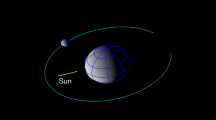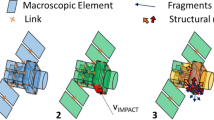Abstract
In a landmark experiment in 1986, the payload of a Delta 180 launch vehicle was made to collide with its second stage rocket. The collision produced two separate debris clouds without any significant center-of-mass cloud. The inclination and plane change angle distributions of the fragments in the two clouds exhibited Gaussian patterns, with the payload cloud having a considerably greater dispersion than the rocket cloud. Several fragments strewn between the two clouds showed some momentum transfer and hence originated from the contact area. The centers of the two clouds moved away from each other in apparent compliance with momentum conservation. The three orthogonal components of the velocity perturbations received by the fragments are calculated and the angular distributions of the fragments obtained. The total velocity perturbations could be fitted with a Maxwellian distribution whereas its components generally followed Gaussian trends. Fragments from the contact areas, including those thrown into high period orbits, generally fell outside these envelopes. A vast majority of the fragments from both clouds received velocity perturbations below the horizontal plane, thus indicating a loss of translational kinetic energy due to the fragmentation. Three preferred directions in the fragment spread in the horizontal plane suggest that the payload hit the rocket body at an angle from behind.
Similar content being viewed by others
References
KLING, R. “Postmortem of a Hypervelocity Impact,” Teledyne Brown Engineering, September 1986.
CHOBOTOV, V. A. and SPENCER, D. B. “Debris Evolution and Lifetime Following an Orbital Breakup,” Journal of Spacecraft and Rockets, Vol. 28, November–December 1991, pp. 670–676.
REMILLARD, S. K. “Debris Production in Hypervelocity Impact ASAT Experiments,” M. S. Thesis, U.S. Air Force Institute of Technology, November 1990.
TAN, A., BADHWAR, G. D., ALLAHDADI, F. A., and MEDINA, D. F. “Analysis of the Solwind Fragmentation Event Using Theory and Computations,” Journal of Spacecraft and Rockets, Vol. 33, January-February 1996, pp. 79–85.
JOHNSON, N. L. “The Collision of Satellites 16937 and 16938,” Teledyne Brown Engineering, 15 November 1986; DTIC Document Number ADA 352037.
ANZ-MEADOR, P. D., TALENT, D. L., and RAST, R. H. “Hazard Analysis for the Breakup of Satellites 16937 and 16938,” Lockheed Engineering and Management Services Co. Inc., February 1987; DTIC Document Number ADA 352037.
KUSPER, R. L. and YOUNG, N. A. “Delta 180 Collision and Fragmentation Analysis (U),” Xontech, July 1987.
BADHWAR, G. D., POTTER, A. E., ANZ-MEADOR, P. D., and REYNOLDS, R. C. “Characteristics of Satellite Breakups from Radar Cross-Section and Plane Change Angle,” Journal of Spacecraft and Rockets, Vol. 25, November–December 1988, pp. 420–426.
BADHWAR, G. D., TAN, A., and REYNOLDS, R. C. “Velocity Perturbation Distributions in the Breakup of Artificial Satellites,” Journal of Spacecraft and Rockets, Vol. 27, May–June 1990, pp. 299–305.
TAN, A. “Ricochet Fragments: A Sufficient Condition for Collision in Space?,” Orbital Debris Monitor, Vol. 9(3), July 1996, pp. 4–7.
TAN, A., ALLAHDADI, F., MAETHNER, S., and WINTER, J. “Satellite Fragmentation: Explosion vs. Collision,” Orbital Debris Monitor, Vol. 6(2), April 1993, pp. 8–13.
COVAULT, C. “SDI Delta Space Experiment to Aid Kill-Vehicle Design,” Aviation Week and Space Technology, 15 September 1986, p. 8.
MEIROVITCH, L. Methods of Analytical Dynamics, McGraw-Hill, 1970, p. 456.
Author information
Authors and Affiliations
Rights and permissions
About this article
Cite this article
Tan, A., Zhang, D. Analysis and Interpretation of the Delta 180 Collision Experiment in Space. J of Astronaut Sci 49, 585–599 (2001). https://doi.org/10.1007/BF03546225
Published:
Issue Date:
DOI: https://doi.org/10.1007/BF03546225




